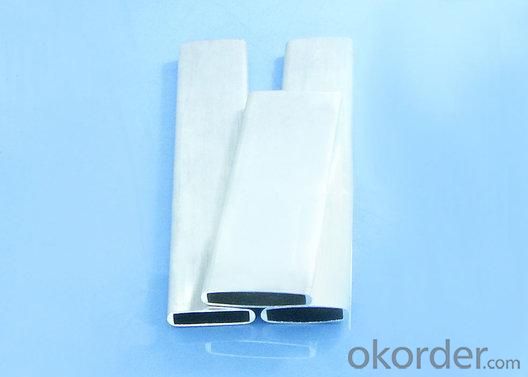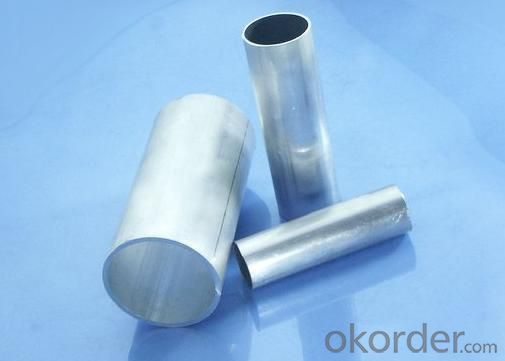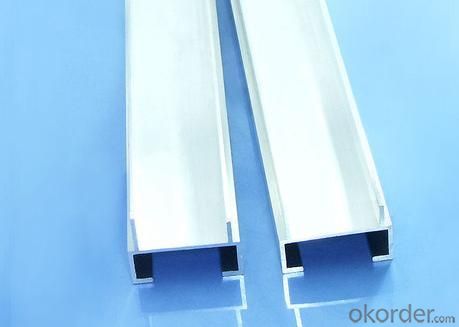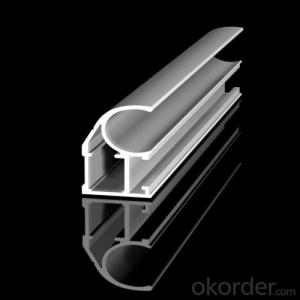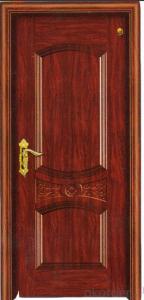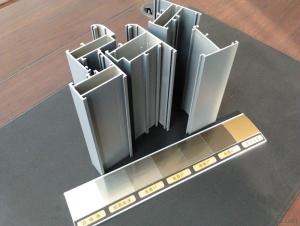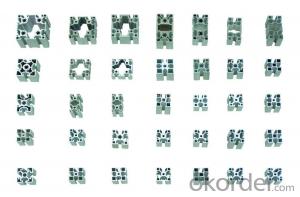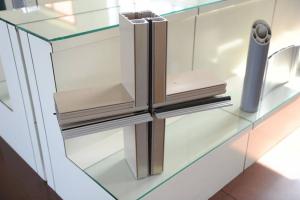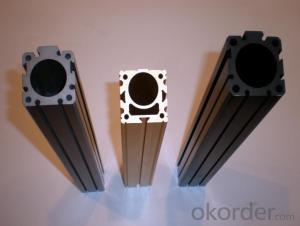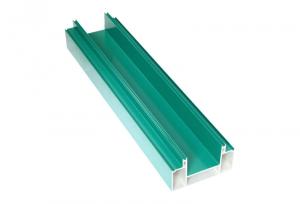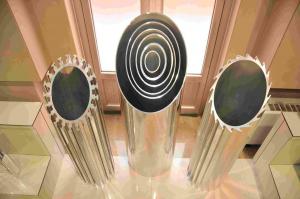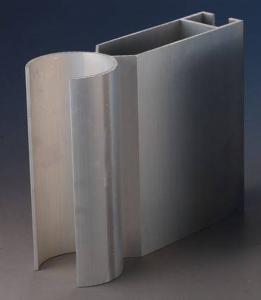Aluminum Profiles for Door and Window
- Loading Port:
- ShenZhen
- Payment Terms:
- TT or LC
- Min Order Qty:
- 10MT m.t.
- Supply Capability:
- 1000 Tons Per Month m.t./month
OKorder Service Pledge
OKorder Financial Service
You Might Also Like
1 Specifications of Aluminum Profiles AA1xxx
Alloy Number | 6063 6061 6060 and different aluminium alloy |
Temper | T4 T5 T6 or other special status |
Surface available | Mill finish, Anodized, Powder Coating, Wooden transfering, electrophoresis, heat insulation, PVDF, and deep processing |
Thickness: | >0.8mm |
Width: | <300mm |
Standard | GB5237.1-2008 |
Special Specification is available on customer’s requirement
2 Usage/Applications of Aluminum Profiles AA1xxx
Aluminium Profiles are widely used in construction(windows & doors,curtain wall), decoration ( flooring and tiling, kitchen) and industry ( heat sink ).
CNBM produces aluminum profiles which meets the national standard GB5237.1-2008. Our strong quality control term bring you the most-qualified products. And with state-of-the-art equipment, and the state owned company background, we have to say, you will understand why there are so many company choose CNBM to be their supplier.
3 Packaging & Delivery of Aluminum Profiles AA1xxx
Packaging:Seaworthy package, bubble plastic bag inside, anti-moisture paper wrapped outside, covered with cartons, on wooden pallets, in containers.
Shipment:the goods will be delivered in 15-30days after getting the buyer's payment.
4 Production Flow of Aluminum Profiles AA1xxx
Aluminium ingot & alloy→melting and casting→extrusion→powder coating→pouring rubber for heat insulation→checkout→packing→PVDF coating\anodizing\electrophoresis→put in products warehouse.
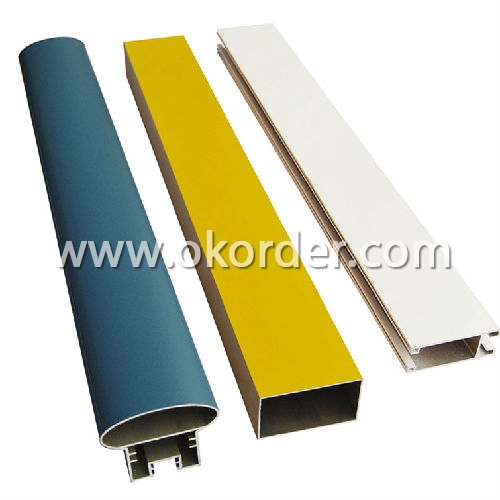
- Q: How do aluminum profiles perform in terms of heat resistance?
- Aluminum profiles possess commendable heat resistance properties, as they possess a relatively high melting point of 660.3°C (1220.5°F) and demonstrate a low coefficient of thermal expansion. These characteristics enable aluminum profiles to endure elevated temperatures without experiencing notable distortion or structural harm. Consequently, aluminum profiles are well-suited for diverse applications that demand heat resistance, including heat sinks, automotive components, and industrial equipment. Furthermore, aluminum's exceptional thermal conductivity facilitates effective dissipation of heat, further augmenting their performance in environments characterized by high levels of heat. Nevertheless, it is imperative to acknowledge that aluminum's heat resistance does not match the level of certain other metals like steel or titanium, thereby necessitating the consideration of alternative materials in exceedingly high-temperature scenarios.
- Q: How do you prevent galvanic corrosion when combining aluminum profiles with concrete or masonry?
- To prevent galvanic corrosion when combining aluminum profiles with concrete or masonry, there are a few steps that can be taken: 1. Use appropriate materials: Select aluminum profiles that are specifically designed for use in contact with concrete or masonry. These profiles are often coated or treated to provide protection against corrosion. 2. Insulate the aluminum profiles: Apply an insulating barrier between the aluminum profiles and the concrete or masonry surfaces. This can be achieved by using non-conductive materials such as gaskets, rubber pads, or coatings. 3. Avoid direct contact: Whenever possible, try to minimize direct contact between the aluminum profiles and the concrete or masonry. This can be accomplished by using spacers or other forms of separation to create a gap between the two materials. 4. Proper installation: Ensure that the aluminum profiles are installed correctly, following the manufacturer's guidelines and recommendations. This includes using appropriate fasteners and techniques to secure the profiles without compromising the insulation or protective measures. 5. Regular maintenance: Regularly inspect the aluminum profiles and the surrounding concrete or masonry for signs of corrosion or damage. Any issues should be addressed promptly to prevent further deterioration. By following these preventive measures, the risk of galvanic corrosion between aluminum profiles and concrete or masonry can be significantly reduced, prolonging the lifespan and performance of the materials involved.
- Q: Can aluminum profiles be used for modular storage systems?
- Certainly! Aluminum profiles are indeed suitable for modular storage systems. This versatile material, known for its lightweight and strong properties, finds extensive use across multiple industries due to its durability and adaptability. When it comes to modular storage systems, aluminum profiles excel in their ability to be easily cut, shaped, and joined together. By utilizing aluminum profiles, one can effortlessly construct customized storage units that can be conveniently adjusted or expanded as required. These profiles can be effectively employed to construct shelving systems, cabinets, drawers, and various other storage components. The modular design facilitates simple assembly and disassembly, enabling hassle-free rearrangement or reconfiguration of the storage system whenever necessary. Moreover, aluminum profiles boast exceptional corrosion resistance, ensuring that the storage system remains in optimal condition even in challenging environments. Additionally, they come in a wide range of finishes, allowing for customization to achieve the desired aesthetic or design specifications. In summary, aluminum profiles offer a cost-effective and long-lasting solution for modular storage systems. Their flexibility, user-friendliness, and durability make them an ideal choice, providing the desired versatility and performance.
- Q: What are the different surface protection coatings for aluminum profiles?
- There are several different surface protection coatings available for aluminum profiles, each offering unique benefits and applications. Some common options include: 1. Anodizing: Anodizing is a widely used coating method that creates a protective layer on the surface of aluminum. It enhances the corrosion resistance, durability, and aesthetics of the profiles. Anodized coatings can be clear or colored, providing options for various design preferences. 2. Powder coating: Powder coating is a popular choice for aluminum profiles due to its durability and versatility. This coating method involves electrostatically applying dry powder to the surface, which is then cured under heat to form a protective layer. Powder coatings offer excellent resistance to UV rays, chemicals, and scratches, while also providing a wide range of color options. 3. Liquid paint coating: Liquid paint coatings are another option for protecting aluminum profiles. This method involves applying a liquid paint to the surface, which is then cured to form a protective film. Liquid paints offer flexibility in terms of color and finish, allowing for customization to meet specific design requirements. 4. E-coating: E-coating, also known as electrocoating or electrodeposition, is a method of applying a paint or coating to aluminum profiles using an electric current. This process creates a uniform and consistent coating, providing excellent corrosion resistance and durability. E-coatings are commonly used in automotive and industrial applications. 5. Ceramic coatings: Ceramic coatings are a newer option for protecting aluminum profiles. These coatings are composed of inorganic materials that provide exceptional hardness, heat resistance, and chemical resistance. Ceramic coatings can enhance the performance and lifespan of aluminum profiles in harsh environments, such as marine or aerospace applications. It is important to consider the specific requirements and intended use of the aluminum profiles when selecting a surface protection coating. Factors such as corrosion resistance, durability, aesthetics, and cost should be taken into account to determine the most suitable coating option.
- Q: Can aluminum profiles be used for window frames?
- Yes, aluminum profiles can be used for window frames. Aluminum is a popular material choice for window frames due to its durability, strength, and resistance to corrosion. It is lightweight, easy to shape, and can withstand various weather conditions, making it a suitable option for window frames. Additionally, aluminum profiles can be customized to fit different window sizes and designs, making them a versatile choice.
- Q: Changhe brand aluminum can?
- Profile is not bad, but visibility is not too large, the whole is still very good, cost-effective
- Q: This question asks for the standard specifications and measurements of aluminum profiles that are frequently utilized in construction projects.
- <p>Aluminum profiles used in construction come in various specifications and measurements. Commonly, they are categorized by series such as 6060, 6061, 6063, and 6082, each with different mechanical properties. Sizes can range from small profiles like 20x20mm to large ones like 200x200mm or more. Thicknesses typically vary from 1mm to 6mm, depending on the structural requirements. Lengths can be customized but are generally available in standard lengths such as 6 meters. The profiles are measured in terms of their width, height, and thickness, and they are designed to meet specific load-bearing and aesthetic needs in construction. It's important to consult with suppliers or construction specifications for the exact measurements required for a particular project.</p>
- Q: This question asks for a list of different types of fasteners that are typically used in conjunction with aluminum extrusions.
- <p>Common types of fasteners used with aluminum extrusions include: 1. T-nuts and T-bolts, which provide a secure way to mount components to the extrusion. 2. Clamps and brackets, which can be used to hold items in place without drilling. 3. Corner brackets, which are used to connect two extrusions at right angles. 4. End caps, which protect the ends of the extrusion and can also serve as a mounting point. 5. Dowel pins, which are used to align and secure extrusions together. 6. Spacers, which maintain a consistent distance between extrusions. 7. Adhesives, which can be used for bonding parts to the extrusion. 8. Rivets, which provide a permanent connection between extrusions and other materials. These fasteners are chosen based on the specific application, load requirements, and design considerations.</p>
- Q: What are the advantages of using aluminum profiles in the automotive aftermarket?
- There are several advantages of using aluminum profiles in the automotive aftermarket. Firstly, aluminum profiles are lightweight, which helps in reducing the overall weight of the vehicle. This, in turn, improves fuel efficiency and performance. Secondly, aluminum profiles offer high strength-to-weight ratio, making them durable and capable of withstanding heavy loads and impacts. Additionally, aluminum is corrosion resistant, which ensures long-lasting performance and reduces maintenance costs. Lastly, aluminum profiles can be easily customized and fabricated, offering flexibility in design and allowing for easy installation in various automotive applications.
- Q: This question asks about potential health hazards related to the use of aluminum profiles in construction.
- <p>There are minimal health risks associated with using aluminum profiles in building construction. Aluminum is a non-toxic metal and does not emit harmful substances. However, during the manufacturing process, if not properly controlled, there might be concerns related to dust and fumes. Additionally, aluminum can react with other materials, potentially causing corrosion or weakening the structure. It's important to ensure that aluminum profiles are used in accordance with safety standards and guidelines to mitigate any potential risks.</p>
1. Manufacturer Overview
| Location | Guangdong, China |
| Year Established | 2006 |
| Annual Output Value | Above US$50 Million |
| Main Markets | Mid East;Eastern Europe;North America |
| Company Certifications | ISO 9001:2000;ISO 14001:2004;OHSAS 18001 |
2. Manufacturer Certificates
| a) Certification Name | |
| Range | |
| Reference | |
| Validity Period |
3. Manufacturer Capability
| a) Trade Capacity | |
| Nearest Port | Nanhai Port |
| Export Percentage | 30%-50% |
| No.of Employees in Trade Department | 21-50 People |
| Language Spoken: | English;Chinese |
| b) Factory Information | |
| Factory Size: | Above 100,000 square meters |
| No. of Production Lines | Above 10 |
| Contract Manufacturing | OEM Service Offered;Design Service Offered |
| Product Price Range | Average |
Send your message to us
Aluminum Profiles for Door and Window
- Loading Port:
- ShenZhen
- Payment Terms:
- TT or LC
- Min Order Qty:
- 10MT m.t.
- Supply Capability:
- 1000 Tons Per Month m.t./month
OKorder Service Pledge
OKorder Financial Service
Similar products
Hot products
Hot Searches
Related keywords



